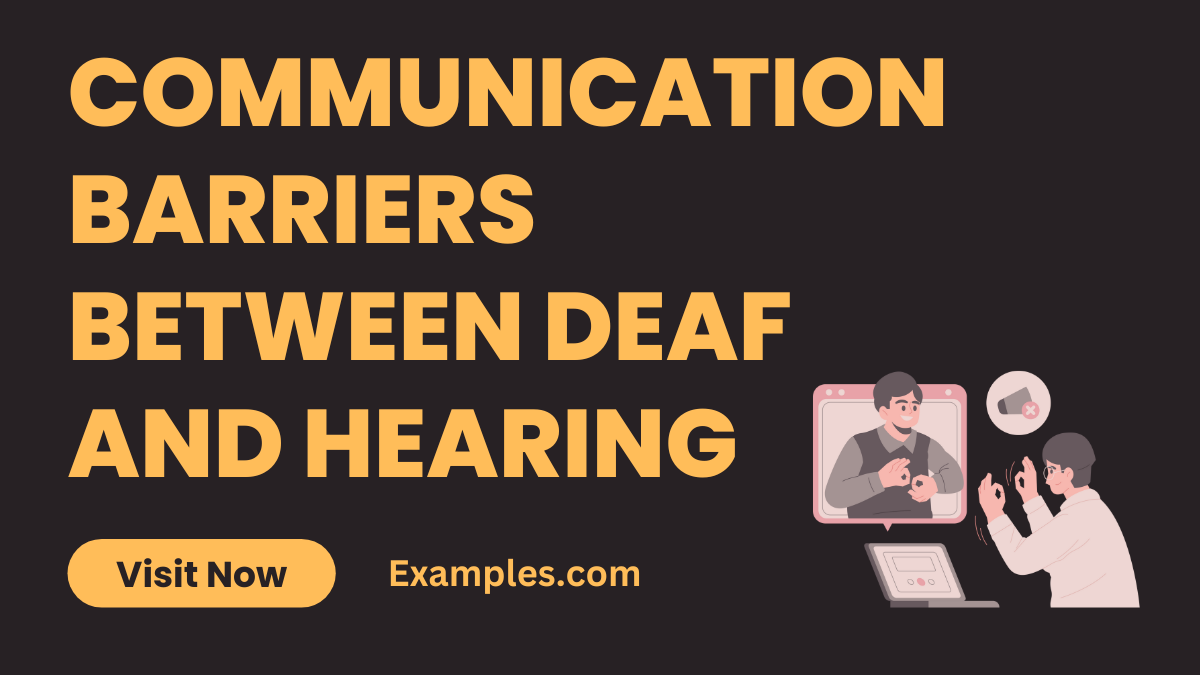19+ Communication Barriers Between Deaf and Hearing Examples
Embark on a comprehensive journey into the intricate landscape of communication barriers between the deaf and hearing. This guide illuminates the complexities through real-life scenarios, providing valuable insights and effective strategies. Uncover the nuances and enrich your understanding of inclusive communication. Welcome to a guide where “Communication Examples” serve as beacons, guiding you through the diverse challenges and solutions in bridging the gap between the deaf and hearing communities.
What is Communication Barriers Between Deaf and Hearing?
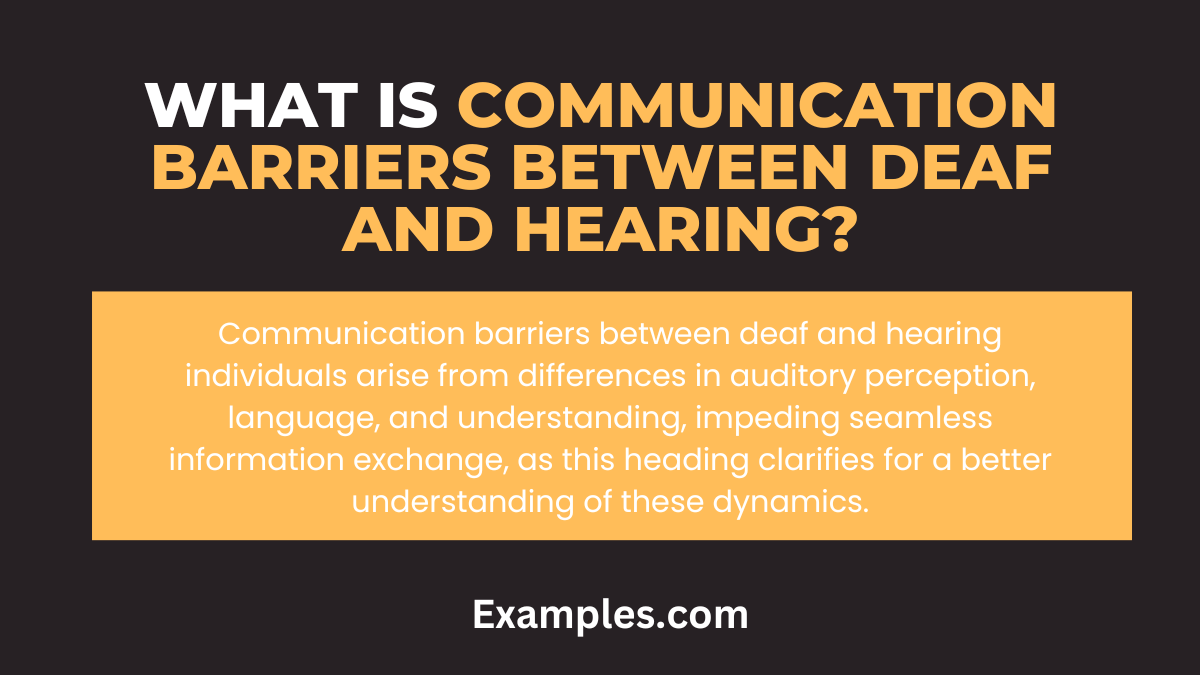
Communication barriers between deaf and hearing individuals encompass challenges hindering effective information exchange. In simple terms, these hurdles stem from differences in auditory perception, language, and understanding, impeding seamless communication. This H2 heading demystifies these complexities, offering a clear and straightforward definition for a better grasp of the dynamics surrounding communication challenges between the deaf and hearing communities.
What is the Best Example of Communication Barriers Between Deaf and Hearing?
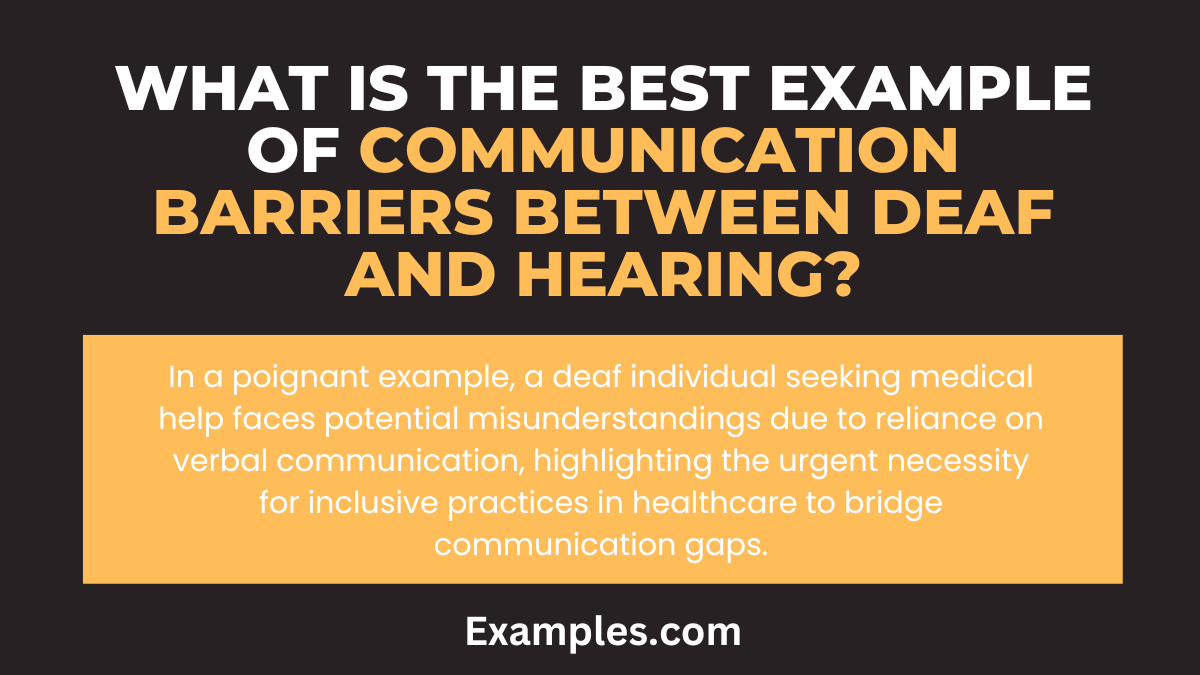
A poignant example of communication barriers involves a deaf individual seeking medical assistance. In this scenario, reliance on verbal communication may lead to misunderstandings, affecting the accuracy of medical history or symptoms shared. This H2 heading delves into this real-world instance, unraveling the intricacies and emphasizing the critical need for inclusive practices to bridge communication gaps in healthcare settings.
20 Communication Barriers Between Deaf and Hearing Examples
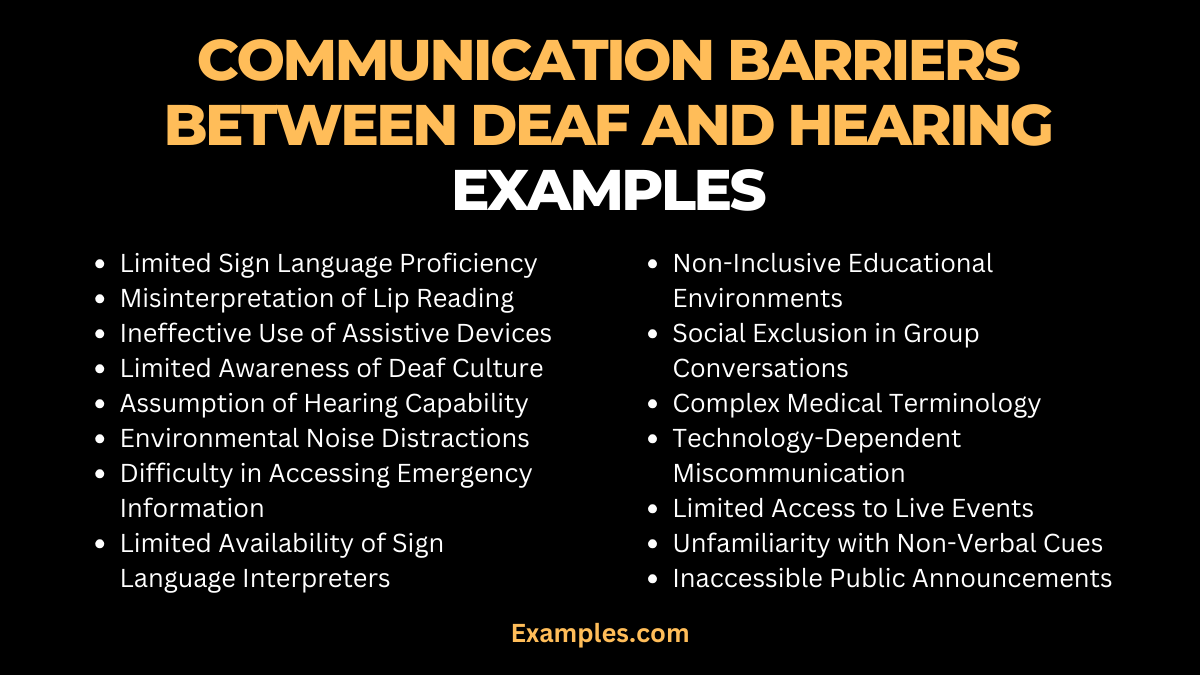
Explore examples illuminating the intricacies of communication barriers between deaf and hearing individuals. Each example provides valuable insights into the diverse scenarios where effective communication encounters hurdles, offering practical solutions for inclusive interactions.
- Limited Sign Language Proficiency:
- Example: In healthcare, a deaf individual may struggle to convey symptoms if healthcare professionals lack sign language proficiency.
- Misinterpretation of Lip Reading:
- Example: During social events, relying solely on lip reading can lead to misunderstandings, highlighting the need for clear visual communication.
- Ineffective Use of Assistive Devices:
- Example: In workplaces, misunderstanding arises when a hearing colleague attempts to communicate using unfamiliar assistive devices.
- Limited Awareness of Deaf Culture:
- Example: In educational settings, a lack of awareness hinders communication when educators overlook deaf cultural nuances.
- Assumption of Hearing Capability:
- Example: In public spaces, assuming all individuals can hear announcements may exclude those relying on visual cues or text-based information.
- Environmental Noise Distractions:
- Example: In emergency situations, background noise may hinder communication for both deaf and hearing individuals relying on auditory alerts.
- Difficulty in Accessing Emergency Information:
- Example: A deaf person relying on written information during emergencies may face delays, emphasizing the need for accessible alerts.
- Limited Availability of Sign Language Interpreters:
- Example: In legal proceedings, the absence of sign language interpreters impedes effective communication for deaf individuals.
- Reliance on Written Communication:
- Example: In customer service, heavy reliance on written communication may result in delayed responses for deaf individuals.
- Non-Inclusive Educational Environments:
- Example: Deaf students face challenges in mainstream classrooms when educational materials lack accessibility.
- Social Exclusion in Group Conversations:
- Example: During gatherings, deaf individuals may feel isolated as group conversations become challenging to follow.
- Complex Medical Terminology:
- Example: Healthcare providers should simplify explanations to ensure deaf patients comprehend complex medical terms.
- Technology-Dependent Miscommunication:
- Example: Video calls may lead to misunderstandings when technical issues disrupt the flow of sign language communication.
- Limited Access to Live Events:
- Example: Deaf individuals miss out on live event experiences when accommodations like sign language interpreters are unavailable.
- Unfamiliarity with Non-Verbal Cues:
- Example: A hearing individual’s unfamiliarity with sign language non-verbal cues may hinder effective communication.
- Barriers in Employment Opportunities:
- Example: Job interviews may be challenging for deaf candidates when interviewers lack awareness about inclusive communication.
- Challenges in Parent-Teacher Communication:
- Example: Parents of deaf children encounter difficulties in school communication without proper accommodations.
- Inaccessible Public Announcements:
- Example: Public spaces must provide visual or text-based alternatives to ensure information accessibility for deaf individuals.
- Reluctance to Seek Help:
- Example: Fear of judgment may prevent both deaf and hearing individuals from seeking help, contributing to prolonged communication challenges.
- Communication Barriers in Social Media:
- Example: Online platforms should enhance accessibility features to ensure inclusive communication for deaf users.
Communication Barriers Between Deaf and Hearing for Students Examples
Navigating the educational landscape presents unique challenges for deaf students. Explore examples illustrating communication hurdles and discover strategies for fostering an inclusive learning environment.
- Limited Access to Lecture Transcripts:
- Example: In classrooms, deaf students may face challenges accessing real-time lecture transcripts, impacting their ability to follow along.
- Barriers in Group Study Sessions:
- Example: During group study sessions, reliance on spoken communication may exclude deaf students from active participation.
- Complexity of Academic Jargon:
- Example: Understanding academic jargon poses difficulties for deaf students, emphasizing the importance of clear explanations.
- Lack of Sign Language Interpreters:
- Example: In seminars and workshops, the absence of sign language interpreters hinders effective communication for deaf students.
- Exclusion in Extracurricular Activities:
- Example: Deaf students may feel excluded from social events when communication relies heavily on verbal interaction.
Communication Barriers Between Deaf and Hearing in the Workplace Examples
In the professional realm, addressing communication barriers between deaf and hearing individuals is crucial. Explore workplace scenarios and strategies for creating an inclusive work environment.
- Challenges in Team Meetings:
- Example: In team meetings, reliance on verbal updates may hinder the active participation of deaf employees, impacting collaboration.
- Communication Gaps in Training Sessions:
- Example: During training sessions, the lack of accessible materials may create communication gaps for deaf employees.
- Unavailability of Sign Language Resources:
- Example: In workplaces, the absence of sign language resources makes it challenging for deaf employees to access critical information.
- Ineffective Communication in Remote Work:
- Example: Remote work environments may pose challenges when video conferencing platforms lack proper accessibility features for deaf employees.
- Issues with Emergency Communication:
- Example: In emergency situations, reliance on audible alarms without visual cues may pose safety concerns for deaf employees.
What is the least effective communication barrier between deaf and hearing people?
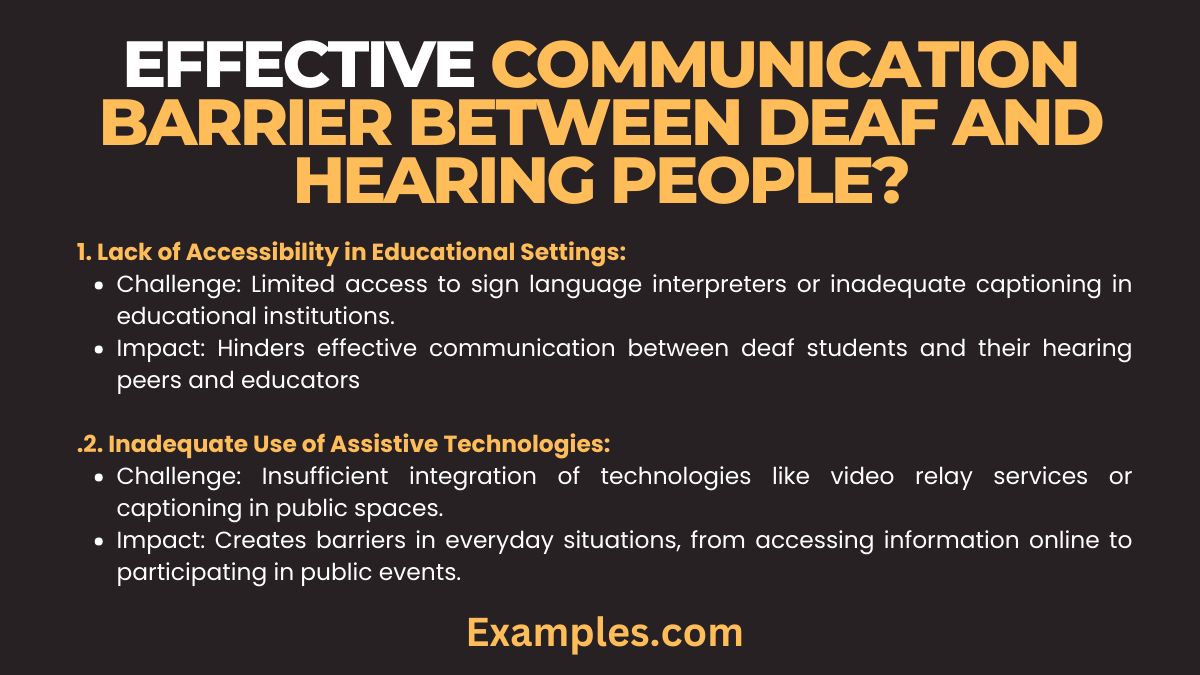
Communication barriers between deaf and hearing individuals can impede effective interaction, and it’s crucial to identify the least effective among them. In this guide, we’ll explore the nuances of these barriers, focusing on pinpointing the least effective one. By understanding and addressing this particular obstacle, we can work towards fostering better communication and inclusivity.
1. Lack of Accessibility in Educational Settings:
- Challenge: Limited access to sign language interpreters or inadequate captioning in educational institutions.
- Impact: Hinders effective communication between deaf students and their hearing peers and educators.
2. Inadequate Use of Assistive Technologies:
- Challenge: Insufficient integration of technologies like video relay services or captioning in public spaces.
- Impact: Creates barriers in everyday situations, from accessing information online to participating in public events.
3. Limited Awareness and Sensitivity:
- Challenge: Low awareness and understanding of deaf culture and communication needs among the hearing population.
- Impact: Results in misunderstandings, exclusion, and unintentional perpetuation of communication barriers.
4. Challenges in Professional Settings:
- Challenge: Lack of accommodations in workplaces, such as the absence of sign language interpreters or accessible communication tools.
- Impact: Affects career growth and collaboration, leading to potential isolation of deaf employees.
5. Communication Gaps in Healthcare:
- Challenge: Limited provision of sign language interpreters or accessible information in healthcare settings.
- Impact: Compromises the quality of healthcare services and patient-doctor communication.
6. Social and Recreational Exclusion:
- Challenge: Inaccessible social events or recreational activities that rely heavily on spoken communication.
- Impact: Limits the participation of deaf individuals in various aspects of social life.
Tips for Communication Barriers Between Deaf and Hearing?
Navigating communication barriers between deaf and hearing individuals requires a thoughtful approach and a commitment to fostering understanding. In this guide, we provide practical tips aimed at enhancing communication and creating inclusive environments.
Introduction: Communication barriers can pose challenges in interactions between deaf and hearing individuals. To promote effective communication and bridge gaps, implementing specific strategies and adopting a proactive mindset is crucial.
1. Embrace Inclusive Communication Modes:
- Encourage the use of diverse communication modes to cater to different preferences.
- Facilitate communication through sign language, written notes, and visual aids to ensure inclusivity.
2. Provide Visual Cues and Context:
- Enhance understanding by offering visual cues and providing contextual information.
- Use gestures, body language, and visual aids to supplement verbal communication for a comprehensive exchange of information.
3. Utilize Assistive Technologies:
- Leverage technology to bridge gaps and enhance communication.
- Explore the use of assistive devices, video relay services, and communication apps for seamless interactions.
4. Foster Patience and Understanding:
- Recognize the importance of patience in navigating communication challenges.
- Cultivate a patient and understanding attitude, allowing time for effective exchange of thoughts and ideas.
5. Educate and Raise Awareness:
- Promote awareness to create a more inclusive and understanding environment.
- Offer educational resources and workshops to enhance awareness about communication diversity.
6. Encourage Open Communication:
- Create an atmosphere where individuals feel comfortable expressing their communication preferences.
- Encourage open dialogue to address concerns and find mutually agreeable communication methods.
7. Establish Clear Communication Protocols:
- Define clear communication protocols to avoid misunderstandings.
- Establish guidelines for effective communication, emphasizing clarity and mutual respect.
In conclusion, addressing communication barriers between deaf and hearing individuals is vital for fostering inclusivity. By embracing diverse communication modes, utilizing assistive technologies, and promoting awareness, we pave the way for understanding. This guide provides practical tips to bridge gaps, emphasizing the importance of patience, education, and open dialogue. Let’s strive for a world where communication knows no barriers.



